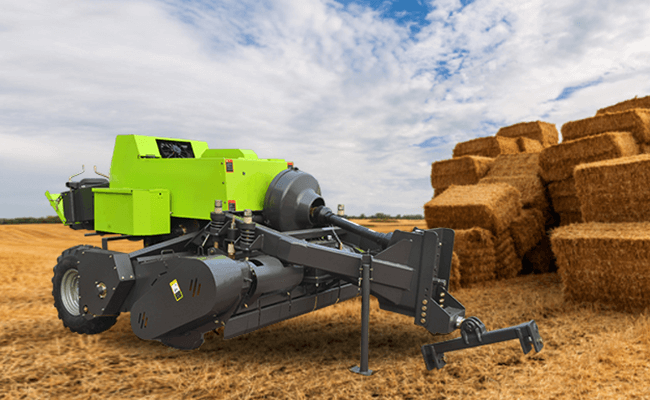In modern agriculture, hay baling is an essential practice for farmers looking to efficiently store and transport forage. Among the most popular choices are round and square bales, each with its unique benefits and drawbacks.
Round bales are typically more cost-effective and easier to store, while square bales offer better stacking and transport efficiency. The choice between round and square bales depends on factors such as farm size, equipment availability, and specific farming needs.
Understanding the differences between these two types of bales can help farmers make informed decisions that maximize their efficiency and productivity.
Contents
History and Evolution of Hay Baling
To fully understand the differences between round and square bales, it is essential to look back at the history and evolution of hay baling. This context not only sheds light on why different types of bales were developed but also provides insights into how advancements in baling technology have shaped modern agricultural practices.
Early Methods of Hay Collection
Before the advent of mechanical balers, hay was collected manually, often resulting in inconsistent quality and substantial labor requirements. This labor-intensive process began to change with the introduction of mechanical baling machines in the 19th century.
Development of Baling Technology
As agricultural technology advanced, so did the methods for hay collection and storage. The invention of mechanical balers revolutionized farming by making it possible to produce consistent, easily transportable bales. Initially, the focus was on creating square bales, which were easier to stack and transport. However, as the needs of farmers evolved, so did baling technology, leading to the development of round balers designed to address different farming requirements.
Types of Bales: Round vs. Square
Understanding the history and technological evolution of hay baling naturally leads us to a closer examination of the two primary types of bales: round and square. Each type has distinct characteristics that influence its use in various farming operations. By exploring these differences, we can better understand the advantages and disadvantages of each bale type and how they cater to different agricultural needs.
Round Bales
Round bales are cylindrical and typically range in size from 4 to 6 feet in diameter. They are rolled tightly, allowing them to shed water effectively, which is ideal for outdoor storage. A standard round bale can weigh between 800 to 1,500 pounds, depending on its size and the type of hay used.
Square Bales
In contrast, square bales come in two main sizes: small and large. Small square bales are usually about 2-3 feet long and weigh between 40 to 60 pounds, making them easy to handle manually. Large square bales can be 3×3 or 4×4 feet and weigh between 1,000 to 2,000 pounds. These bales are often preferred for large-scale operations due to their uniform size and density, which makes them ideal for transport and storage.

Benefits of Round Bales
Having outlined the fundamental differences between round and square bales, it’s time to dive deeper into the specific benefits of each type. Let’s start by examining the advantages of round bales, which are often favored by smaller farms and those looking for cost-effective, easy-to-handle solutions.
Cost Efficiency
Round balers tend to be less expensive than their square counterparts, both in terms of initial purchase price and maintenance costs. They also require less manpower to operate, which can significantly reduce labor expenses. For instance, the cost of a new round baler might range from $15,000 to $30,000, while a square baler could cost upwards of $50,000.
Ease of Storage and Handling
One of the main advantages of round bales is their ease of handling. Farmers can roll them across fields, simplifying movement without needing specialized equipment. Additionally, their shape and water-shedding abilities allow round bales to be left outdoors with minimal risk of spoilage.
Weather Resistance
Round bales are designed to shed water, reducing the amount of spoilage that occurs when they are stored outside. Studies have shown that round bales can reduce spoilage by up to 30% compared to square bales when stored in the open. This makes them particularly advantageous in regions with unpredictable weather patterns.
Feeding and Nutritional Benefits
When it comes to feeding livestock, round bales offer a more controlled feeding rate, which can be beneficial for animals that require a steady intake of nutrients. The tighter packing of round bales also helps preserve the nutritional value of the hay, ensuring that livestock receives high-quality feed.
Benefits of Square Bales
While round bales have their distinct advantages, square bales also offer numerous benefits that make them an attractive option for many farmers. Let’s explore the specific reasons why square bales might be the preferred choice for large-scale operations or for those looking for consistent quality and ease of transport.
Ease of Transport and Stacking
Square bales, especially large ones, are much easier to stack and transport. Their uniform shape allows for more efficient use of space during transport, which can significantly reduce fuel costs and time. A standard flatbed trailer can carry up to 36 large square bales, compared to only 24 round bales of the same weight, showcasing their efficiency in space utilization.
Consistent Bale Density
Square bales are typically denser than round bales, which ensures a consistent weight and quality. This uniformity is particularly important for commercial hay producers who sell to markets that demand high-quality forage. The density of square bales also makes them easier to handle with machinery, reducing the labor required for moving and stacking.
Versatility in Usage
Farmers use square bales in various operations, and they are especially popular in the equine industry, where small square bales are preferred for their easy handling and precise feeding capabilities. Moreover, square bales are ideal for both manual and mechanical feeding systems, making them a flexible choice for farms of all sizes.
Market Demand and Commercial Value
Due to their ease of handling and consistent quality, square bales often command a higher price in the market. In some regions, they are the preferred choice for exporting hay, particularly in the equine and dairy industries. This higher market value can be a deciding factor for farmers looking to maximize their profits.

Comparing Round and Square Bales: Key Factors
Now that we’ve covered the individual benefits of round and square bales, it’s essential to compare them side by side. This comparison will help highlight the key factors that farmers should consider when choosing between the two types, ensuring they select the best option for their specific needs and circumstances.
Cost of Machinery and Maintenance
The initial investment and ongoing maintenance costs are significant considerations when choosing between round and square bales. While round balers are generally less expensive, square balers can offer better long-term value due to their higher efficiency and productivity in large-scale operations.
Labor Requirements
Square bales typically require more manpower to handle, especially if manual stacking and transport are involved. However, with the right equipment, this labor can be minimized. Round bales, on the other hand, are easier to handle and require less labor, making them a cost-effective choice for smaller farms or operations with limited labor availability.
Storage and Transportation
Square bales offer superior storage efficiency due to their stackable shape, allowing farmers to store more hay in a given space. They are also easier to transport, as their uniform shape allows for tighter packing on trailers. Round bales, while easier to handle individually, require more space for storage and transportation, which can increase costs in the long run.
Quality of Hay and Nutritional Value
The type of bale can also affect the quality and nutritional value of the hay. Round bales, with their tighter packing, tend to preserve nutrients better and are less prone to spoilage when stored outside. Square bales, however, provide more consistent quality and are less likely to develop mold if stored properly.

Choosing the Right Bale for Your Farm
Given the various factors that influence the choice between round and square bales, it’s crucial for farmers to carefully evaluate their specific needs and resources. By considering elements such as farm size, livestock type, and climate conditions, farmers can make an informed decision that best suits their operation.
Assessing Farm Needs and Resources
When deciding between round and square bales, it’s essential to consider your farm’s specific needs and resources. Factors such as the size of your operation, the types of livestock you have, and your climate conditions will all play a role in determining which type of bale is best suited for you.
Long-Term Planning and Investment
Investing in the right equipment is a crucial decision for any farm. While round balers may offer lower upfront costs, square balers can provide better long-term value for larger operations. It’s important to consider not just the initial purchase price but also the long-term savings and potential for increased productivity.
Environmental Considerations
Don’t overlook the environmental impact of your baling choice. Storing round bales outside can reduce the need for additional storage facilities, thereby minimizing land use and construction costs. Square bales, with their efficient stacking, can reduce the overall footprint of hay storage, making them a more sustainable option for some farms.
Future Trends in Hay Baling
As we look to the future, it’s clear that the hay baling industry will continue to evolve, driven by technological innovations and a growing emphasis on sustainability. Staying informed about these trends can help farmers adapt to changing conditions and ensure their operations remain efficient and productive.
Technological Innovations
The hay baling industry continually evolves as new technologies emerge to improve efficiency and reduce costs. Smart balers and automated systems are becoming more common, allowing farmers to optimize their operations and reduce labor requirements.
Sustainable Practices and Environmental Impact
As environmental concerns continue to grow, there is increasing interest in sustainable baling practices. This includes the use of biodegradable twine, reducing plastic use, and implementing more efficient storage and transport methods to minimize the carbon footprint of hay production.
Market Trends and Farmer Preferences
Market demands and farmer preferences are constantly shifting. While round bales remain popular for their cost-effectiveness and ease of use, square bales are gaining traction in markets that demand higher quality and consistency. Keeping an eye on these trends can help farmers make informed decisions about their hay production.
Conclusion
In conclusion, both round and square bales have their advantages and disadvantages. Round bales are generally more cost-effective and easier to handle, making them a great choice for smaller farms or operations with limited resources. Square bales, on the other hand, offer better stacking and transport efficiency, making them ideal for larger farms or those looking to maximize their profits.
FAQs
When choosing a baler, consider factors such as the size of your operation, the types of livestock you have, your storage and transportation needs, and your budget. It’s also important to consider long-term maintenance costs and potential resale value.
Yes, square bales generally require more expensive equipment and have higher maintenance costs. However, they offer better efficiency for large-scale operations, particularly in terms of storage and transport.
For small farms, round bales are often the better choice due to their lower cost and ease of handling. They require less specialized equipment and can be stored outdoors, making them ideal for operations with limited resources.

